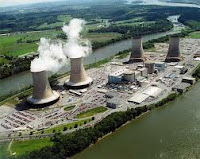Pennsylvania - Three Mile Island accident was a partial meltdown at Unit 2 at Three Mile Island nuclear plant in Dauphin County, Pennsylvania, near Harrisburg in 1979. The plant was owned and operated by General Public Utilities and the Metropolitan Edison Co. The accident at Three Mile Island began about 04.00 clock on March 28, 1979, when the plant experienced a failure in the Secondary, a non-nuclear plant.
The pumps supply water main has stopped running, or by a mechanical or electrical failure that causes prevented the steam generators from removing heat. First the turbine, then shutting down the reactor automatically. Immediately began the pressure in the primary circuit to increase. To avoid this pressure is too high, opened the valve controlled pressure relief. The valve should be closed when the pressure decreased by a certain amount, but it has not. Signals available to the operator has not demonstrated that the valve remains open. Open as a result of cooling water poured on the valve stuck and caused the reactor core to overheat.
The accident at Three Mile Island was the worst in American history operating commercial nuclear power plants, although it caused no deaths or injuries to plant workers or members of the nearby community. But major changes in emergency planning, training for reactor operators, human factors engineering, radiation protection and many other fields of nuclear power plants. In addition, caused the U. S. Nuclear Regulatory Commission to streamline and strengthen regulatory oversight. The resulting changes in the nuclear industry and the NRC had the effect of increasing security.
The core of the reactor fuel TMI-2 has become uncovered and more than a third of the fuel melted. Inadequate instrumentation and training programs both hindered the ability of operators to respond to the accident. The accident was accompanied by communication problems that led to conflicting information available to the public, contributing to public fears. Radiation was released from the factory. Discharges are not serious and are not health risks. This was confirmed by thousands of environmental samples and other measures taken during the accident. The containment building worked as designed. Despite the merger of approximately one third of the base fuel, the reactor vessel itself maintained its integrity and contained the damaged fuel.
3/12/11
Subscribe to:
Post Comments (Atom)
 RSS Feed
RSS Feed
0 comments:
Post a Comment